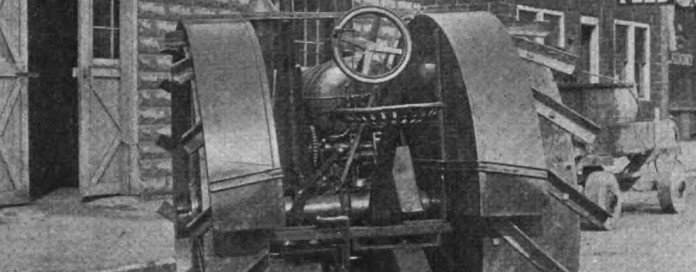
The Pontiac automobile made its debut at the New York Auto Show in January 1926 as an offshoot of the larger and more expensive Oakland. A roaring success at first (it outsold the Oakland,which was discontinued in 1931), the Pontiac was popular into the 21st century, but was finally killed by GM in December of 2009.
So much for the car — did you know there was also a Pontiac tractor? Well, there was, but it wasn’t made by the same company.
Pre-WWI
Nathan A. Wright, of Pontiac, Michigan, began tinkering with a light tractor several years prior to World War I. After some experimentation and several test models, he declared his design perfected and started the Pontiac Tractor Company to build the thing.
The new Pontiac 15-30, the only model built by the firm, was introduced to the trade in the October 1918 issue of Tractor World magazine.
The design of the Pontiac was already outdated by 1918, with a single-cylinder, horizontal engine with a 9-inch bore and a 12-inch stroke that developed 34.4 HP at 500 RPM. Instead of the heavy cast base common on this type of engine, the Pontiac engine used a combined engine base and tractor frame made of one length of 15-inch steel channel, which gave strength while saving a lot of weight.
The cooling system was the venerable hopper type, which the company bragged, “..obviates the use of pump, fan, radiator and pipe connections of all kinds.”
Kerosene was the fuel of choice, and ignition was of the jump spark type, with current fed from a storage battery or dry cells through a vibrator coil. The engine cylinder was lubricated by a “simple type of force feed with a sight glass” (probably a mechanical oiler), and the Babbitt bearings with screw down grease cups.
Outdated mechanics
The drive system used by Wright was also falling out of favor by 1918. Although the Pontiac had two 60-inch diameter rear wheels, only the right hand one was driven. A sprocket on the engine crankshaft, which also had a large flywheel on each side, drove a jackshaft underneath the engine through a heavy roller chain.
A bull pinion on the right end of this jackshaft meshed with the internal bull gear, which was bolted to the inside of the rim of the right-hand drive wheel. The bull gear and pinion was “completely enclosed and constantly lubricated, so wear should be negligible even in the hardest service.” There was no differential, the right hand rear wheel doing all the driving. A hand clutch lever allowed the driver to engage the left wheel with the rear axle for straight ahead or rear movement, and to disengage it to free-wheel while turning.
There was no variable speed transmission, as only one forward and one reverse gear was available.
For the masses
The Pontiac Tractor Company claimed that their goal “..was to construct (a tractor that) could be sold for a comparatively low price, could be used for widely varying work, could be worked for very small expense, would have long service life, would have endurance and because of its mechanical simplicity, could be maintained, adjusted, and repaired for minimum cost and by those not mechanically expert.”

The Pontiac was “built for all-around farm work” such as plowing, harrowing, discing, cultivating, threshing, hauling and supplying belt power. With an estimated 15 HP at the drawbar, the tractor was said to be able to handle three 14-inch plow bottoms in any kind of soil.
The Pontiac tractor had two close-set front wheels at the front end of a cast gooseneck jutting forward from the frame channel and steering was by a worm and sector automotive-type steering gear. It was claimed that the tractor could work “in very limited spaces because of the short turns that can be made, as the left wheel can be instantly disengaged by the movement of a hand lever.”
The operator’s platform was protected from the lugged rear wheels by flat fenders that covered the tops and insides of the wheels, and a spring mounted seat was provided.
Dismal demand
At least a few Pontiac tractors were sold as the article told of a farmer at Milan, Michigan, who had owned a Pontiac for two years and during 1928 “..he has plowed, disced and harrowed more than 260 acres. In addition he had done considerable belt work and the total cost of maintenance for the year has been less than $10.”
The city of Pontiac also had one of the tractors that was used by the street department for “..hauling, construction, grading, etc., and it has given excellent service at very small expense.”
When the story was written in late 1918, production was said to be one finished tractor per day, and plans were to turn out 1,000 tractors for 1919. Apparently the demand for the Pontiac tractor didn’t live up to expectations as no further mention of the Pontiac tractor can be found and, so far as I know none have survived.
The Pontiac Tractor Company did, however, seem to have made a small hit and miss engine, probably to power their spray rigs, and there are a few of these Pontiac engines in the hands of collectors.
More from Wright
In 1923, Nathan Wright patented an orchard sprayer that was attached to the front of a tractor so it could be easily maneuvered into and out of close places in an orchard, and a couple of years later a power post-hole digger that also mounted on the front of a tractor.
Interestingly, the patent drawing for the sprayer shows it attached to a Fordson tractor, while the post-hole digger is on a McCormick-Deering 10-20 or 15-30, further proof that the Pontiac tractor didn’t last long.











